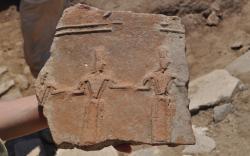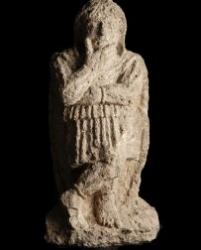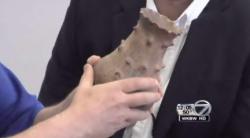INSTITUT SUPERIEUR D'ANTHROPOLOGIE
INSTITUTE OF ANTHROPOLOGY
ONLINE COURSES / COURS A DISTANCE
INSCRIPTION 2012 / Session III : Juillet 2012
REGISTRATION 2012 / Term III : July 2012
PEROU –  Lima - On a street corner, under a garbage dump, at a construction site -- pre-Inca archeological sites abound in Lima, where the ruins of hundreds of sacred places, or "huacas", are at the mercy of urban growth and public indifference. In the middle of the Miraflores residential district, one of Lima's best restaurants opens onto the terrace of an ancient pyramid, offering fine food in a 1,500 year-old setting bathed in artificial lighting. The Huaca Pucllana, the city's archeological star, has been impeccably preserved thanks to a partnership with the restaurant, but the rare public-private initiative is an exception to the rule. About three kilometers (two miles) away, in the densely populated Chorrillos neighborhood, a sign marks the existence of an "intangible archeological zone". Its base is heaped with garbage. A small Catholic shrine sits in the middle of the huaca, built "thanks to the patronage" of the local mayor, as another sign says. There is no registry that keeps track of the huacas -- which comes from the Quechua word "wak'a" meaning sacred place -- but archeologists say more than 300 of the adobe structures are spread around this city of nine million people. Archeologist Elias Mujica recalls that the presidential palace on the Plaza de Armas -- or its predecessor built by Francisco Pizarro after founding Lima in 1535 -- was erected on top of the Taulichusco palace, the seat of the city's government in pre-Columbian times. The colonial city hall built in 1549 is on another sacred site, the Cabildo huaca, and a temple dedicated to the god Puma Inti once stood where the cathedral is today. The remaining huacas "for the most part are not protected, which is why they have been invaded by families without homes, or turned into dumps or refuges for delinquents," said Luis Caceres, director of archeology at the Culture Ministry. There are notable exceptions like Pucllana or the Huallamarca huaca, a vast second century pyramid that today is enclosed by a park and museum. But most of Lima's huacas face an uncertain future due to a lack of money for conservation projects, said Caceres.
Lima - On a street corner, under a garbage dump, at a construction site -- pre-Inca archeological sites abound in Lima, where the ruins of hundreds of sacred places, or "huacas", are at the mercy of urban growth and public indifference. In the middle of the Miraflores residential district, one of Lima's best restaurants opens onto the terrace of an ancient pyramid, offering fine food in a 1,500 year-old setting bathed in artificial lighting. The Huaca Pucllana, the city's archeological star, has been impeccably preserved thanks to a partnership with the restaurant, but the rare public-private initiative is an exception to the rule. About three kilometers (two miles) away, in the densely populated Chorrillos neighborhood, a sign marks the existence of an "intangible archeological zone". Its base is heaped with garbage. A small Catholic shrine sits in the middle of the huaca, built "thanks to the patronage" of the local mayor, as another sign says. There is no registry that keeps track of the huacas -- which comes from the Quechua word "wak'a" meaning sacred place -- but archeologists say more than 300 of the adobe structures are spread around this city of nine million people. Archeologist Elias Mujica recalls that the presidential palace on the Plaza de Armas -- or its predecessor built by Francisco Pizarro after founding Lima in 1535 -- was erected on top of the Taulichusco palace, the seat of the city's government in pre-Columbian times. The colonial city hall built in 1549 is on another sacred site, the Cabildo huaca, and a temple dedicated to the god Puma Inti once stood where the cathedral is today. The remaining huacas "for the most part are not protected, which is why they have been invaded by families without homes, or turned into dumps or refuges for delinquents," said Luis Caceres, director of archeology at the Culture Ministry. There are notable exceptions like Pucllana or the Huallamarca huaca, a vast second century pyramid that today is enclosed by a park and museum. But most of Lima's huacas face an uncertain future due to a lack of money for conservation projects, said Caceres.
http://www.naharnet.com/stories/en/38562-lima-s-sacred-pre-inca-huacas-fall-prey-to-growth
CHYPRE –  Larnaca - Ancient tombs hailing from the Phoenician period between the 4th and 6th century BCE were discovered on Sunday on Faneromeni Avenue in Larnaca during work on the town’s sewage system. According to archaeologists, the graves may be an extension of the ancient tomb known as the catacomb which dates back to the 4th century BCE and can be found under the old church of Panayia Faneromeni. Larnaca town and especially the Faneromeni area was a vast cemetery in antiquity, with scattered tombs known as ‘Larnaces’, which is how the city of Zeno took its name. Father Michael, a priest from the nearby Church of Panayia Faneromeni, said plans have been prepared for the renovation of the catacomb under the old church and the creation of an underground museum.
Larnaca - Ancient tombs hailing from the Phoenician period between the 4th and 6th century BCE were discovered on Sunday on Faneromeni Avenue in Larnaca during work on the town’s sewage system. According to archaeologists, the graves may be an extension of the ancient tomb known as the catacomb which dates back to the 4th century BCE and can be found under the old church of Panayia Faneromeni. Larnaca town and especially the Faneromeni area was a vast cemetery in antiquity, with scattered tombs known as ‘Larnaces’, which is how the city of Zeno took its name. Father Michael, a priest from the nearby Church of Panayia Faneromeni, said plans have been prepared for the renovation of the catacomb under the old church and the creation of an underground museum.
http://www.cyprus-mail.com/sewerage-works/sewerage-work-uncovers-ancient-tombs/20120501
FRANCE –  Lectoure - La statue gallo-romaine du berger Attis découverte en 1868 dans le Lectourois a été acquise par le musée d'archéologie nationale de Saint-Germain-en-Laye. Le magistrat Gustave Clément-Simon l'avait achetée au XIXe siècle. Il l'a emportée dans son château de Naves, en Corrèze, à la retraite. Elle est passée dans plusieurs successions avant d'atterrir dans une salle des ventes à Louviers (Eure). La vente aux enchères s'est déroulée le 15 avril mais le résultat n'est arrivé que ces derniers jours.
Lectoure - La statue gallo-romaine du berger Attis découverte en 1868 dans le Lectourois a été acquise par le musée d'archéologie nationale de Saint-Germain-en-Laye. Le magistrat Gustave Clément-Simon l'avait achetée au XIXe siècle. Il l'a emportée dans son château de Naves, en Corrèze, à la retraite. Elle est passée dans plusieurs successions avant d'atterrir dans une salle des ventes à Louviers (Eure). La vente aux enchères s'est déroulée le 15 avril mais le résultat n'est arrivé que ces derniers jours.
http://www.ladepeche.fr/article/2012/04/30/1342637-lectoure-la-statue-d-attis-ira-a-saint-germain-en-laye.html
FRANCE –  Reims - Ça bouge enfin autour de l'ancienne caserne Colbert. Les archéologues de l'Inrap ont investi le terrain. Nez dans la terre, binette et ratissoire à la main, ils traquent le vestige. Ils ont mission de fouiller sur deux zones, que le diagnostic préalable a permis de délimiter. « Il s'agit en tout d'une surface de 8 000 m2 », fait savoir l'Inrap. Le secteur s'annonce prometteur : « On se trouve au lieu de passage de plusieurs enceintes de la ville à différentes époques. Sont notamment concernés l'époque gauloise et le Moyen Âge. Retrouver les différentes murailles, voies ou fossés va nous permettre de vérifier les limites de la ville aux époques en question. » Les trouvailles des archéologues pourraient aussi ne pas se limiter à des fortifications : « Nous avons trace d'une occupation humaine datant du haut empire gallo-romain. » Des objets usuels de cette période pourraient donc être retrouvés. « Il est trop tôt pour s'avancer, mais on espère bien quelques trouvailles. » Les archéologues ont six mois pour mener leurs recherches.
Reims - Ça bouge enfin autour de l'ancienne caserne Colbert. Les archéologues de l'Inrap ont investi le terrain. Nez dans la terre, binette et ratissoire à la main, ils traquent le vestige. Ils ont mission de fouiller sur deux zones, que le diagnostic préalable a permis de délimiter. « Il s'agit en tout d'une surface de 8 000 m2 », fait savoir l'Inrap. Le secteur s'annonce prometteur : « On se trouve au lieu de passage de plusieurs enceintes de la ville à différentes époques. Sont notamment concernés l'époque gauloise et le Moyen Âge. Retrouver les différentes murailles, voies ou fossés va nous permettre de vérifier les limites de la ville aux époques en question. » Les trouvailles des archéologues pourraient aussi ne pas se limiter à des fortifications : « Nous avons trace d'une occupation humaine datant du haut empire gallo-romain. » Des objets usuels de cette période pourraient donc être retrouvés. « Il est trop tôt pour s'avancer, mais on espère bien quelques trouvailles. » Les archéologues ont six mois pour mener leurs recherches.
http://www.lunion.presse.fr/article/autres-actus/premiers-travaux-sur-le-site-de-colbert
USA –  Spiro Mounds - Goodwill Industries of Western New York receives about 50,000 pounds in donations per day...and sometimes they find something a little extra special. "This is a vase we found in our warehouse," Dan Victori with Goodwill Industries of Western New York said. It's not just any old flowering pot. "The vase could be anywhere from 1,000 to 1500 years old. A note inside the vase said it was found at the Spiro Mounds in 1970. We did research to discover that was an old Indian burial grounds," Victori said.
Spiro Mounds - Goodwill Industries of Western New York receives about 50,000 pounds in donations per day...and sometimes they find something a little extra special. "This is a vase we found in our warehouse," Dan Victori with Goodwill Industries of Western New York said. It's not just any old flowering pot. "The vase could be anywhere from 1,000 to 1500 years old. A note inside the vase said it was found at the Spiro Mounds in 1970. We did research to discover that was an old Indian burial grounds," Victori said.
http://www.wkbw.com/news/local/Vase-149668485.html